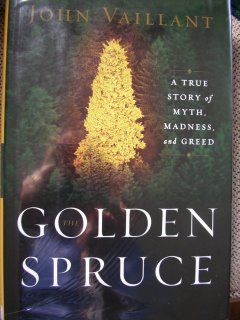
THE GOLDEN SPRUCE: a true story of myth, madness and greed
Canadian author John Vaillant’s first "nature noir" work is set in British Columbia’s Queen Charlotte Islands. At it’s base it is the story of the dissolution of the Pacific Northwest’s temperate rain forest that is now being completed. Vaillant asserts that 90% of the American and 60% of the Canadian Pacific Northwest old growth forest is gone as of 2005. This Canadian author elucidates, in the course of his well researched work, what all of humankind loses as a result of the passing of this resource.
The Golden Spruce is much more than just a scientific and statistical treatise on the temperate rain forest; it delves into the lives of the Haida Indians and their spiritual attachment to the mutant Golden Spruce. This 300 year old chlorotic Sitka spruce tree, on the Queen Charlotte’s Nelson Island, was the only individually living organism that was told of in Haida stories. The story of K’iid K’iyaas—the golden spruce— was one of many Haida morality stories that was connected to an object on the land; but it was an individual living thing, not a rock or type of animal that legendarily got its characteristics through ancestral actions. Says Vaillant:
The golden spruce, in fact, was uniquely suited to bridge the gaps of time and culture. Trees are the only readily visible living things with such tremendous temporal reach, and no other tree was so strangely distinctive, so undeniably Other, that it could be recognized instantly by anyone, no matter what their culture, or at what point in history they came upon it. Left in peace, the golden spruce could have lived until the twenty-sixth century. [p. 157, The Golden Spruce ]
Most of the people who inhabit the nonfiction pages of the book are loggers, foresters and people involved in the forest product industry. Grant Hadwin, the chief character that The Golden Spruce centers around, is a logger and survivalist woodsman who, through many years of work in the logging industry, came to believe that the modus operandi of logging in the Pacific Northwest couldn’t be reconciled with the damage done to the environment.
In a carefully planned out scheme, debatedly psychotic Hadwin floats himself with chainsaw down the Yakoun River in winter weather and cuts the golden spruce so that it will fall with the first big wind. A letter sent to the media by Hadwin asserts that his reason for cutting the golden spruce was to get revenge on the giant logging company MacMillan Bloedel for their desecration of the old growth forest and waters that they have perpetrated in Canada. The golden spruce, that loggers had left due to its uniqueness was termed by Hadwin as the company’s "pet tree’. Author Vaillant sees the golden spruce and its cutting as much more: "Hadwin had cut down what may have been the only tree on the continent capable of uniting natives, loggers and environmentalists, not to mention scientists foresters and ordinary citizens in sorrow and outrage."
Hadwin’s response to the sorrow and outrage from others, as stated to a reporter: "When society places so much value on one mutant tree and ignores what happens to the rest of the forest, it’s not the person who points that out who should be labeled."
Hadwin disappears en route from the mainland across treacherous Hecate Strait by kayak for his trial on a charge of felony criminal mischief and illegal cutting of timber on crown land. His kayak and gear was found wrecked on a small island 75 miles from his departure point. Many local people still believe he is alive as this wasn’t the first time that he had gone missing.
Author Vaillant, through interviews of Hadwin’s co-workers and those close to him, develops plausible reasons for Hadwin’s actions and the unknown elements in Hadwin’s disappearance.
Vaillant’s interviews of many woods workers uncovers the mixed feelings that many of them have about the part they play in the destruction of the temperate rain forest. Says Vaillant, ‘The individual’s love of the woods exists in tandem with a collective industrial "rape and run" mentality that over time has left scoured valleys and fouled streams littered with machinery, fuel drums, old tires, and thousands of yards of rusted cable.’
If Grant Hadwin is still alive he must be disappointed that his attempts to draw attention to big logging’s destruction of old growth forest appear to have come to naught. Canada’s old growth forest continues to be clear cut . Hadwin’s "lesson" to the public appears to have been lost in the face of numerous eulogies and attempts to graft and clone another golden spruce.
Author John Vaillant rightfully leaves the reader without any hope to change our anthropocentric attitude toward humankind’s place on our planet. The temperate rain forest ecosystem is just one more victim in man’s "development of our resources."

